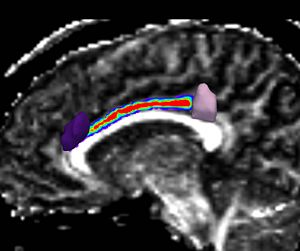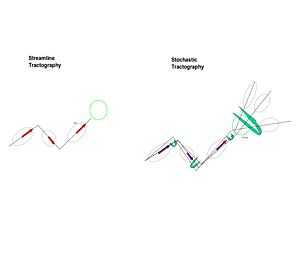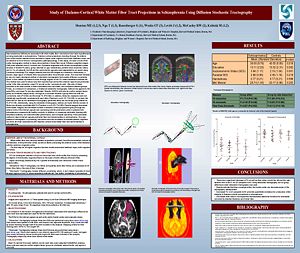Difference between revisions of "DBP2:Harvard:Brain Segmentation Roadmap"
From NAMIC Wiki
| Line 16: | Line 16: | ||
; B - Possible Applications | ; B - Possible Applications | ||
| − | :* Since diffusion direction uncertainty within the gray matter is quite significant; principal diffusion direction approaches usually do not work for tracking between two gray matter regions. Thus if one requires finding connections between a priori selected anatomical gray matter regions, defined either by anatomical segmentations (in case of using structural ROI data), or functional activations (in case of megring DTI with fMRI), stochastic tractography seems to be the method of choice. Here is an example of this application to anatomical data (Figure 1) and to fMRI data (Figure 2). | + | :* Since diffusion direction uncertainty within the gray matter is quite significant; principal diffusion direction approaches usually do not work for tracking between two gray matter regions. Thus if one requires finding connections between a priori selected anatomical gray matter regions, defined either by anatomical segmentations (in case of using structural ROI data), or functional activations (in case of megring DTI with fMRI), stochastic tractography seems to be the method of choice. Here is an example of this application to anatomical data (Figure 1) and to fMRI data (Figure 2). [[Image:Cingulate_gyrus.jpg|thumb|300px|Figure 2: stochastic tractography reveals anatomical connection between anterior and posterior cingulate gyrus activated during fMRI Color Stroop task]] |
| − | [[Image:Cingulate_gyrus.jpg|thumb|300px|Figure 2: stochastic tractography reveals anatomical connection between anterior and posterior cingulate gyrus activated during fMRI Color Stroop task]] | + | :* Stochastic Tractography is also comparable, if not better, in defining large white matter fiber bundles, especially those traveling through white matter regions characterized by increased diffusion uncertainty (fiber crossings). Example of such application to internal capsule. (Figure 3)[[Image:IC_sto.jpg|thumb|300px|Figure 3: Comparison of stochastic and deterministic tractography models]] |
| − | :* Stochastic Tractography is also comparable, if not better, in defining large white matter fiber bundles, especially those traveling through white matter regions characterized by increased diffusion uncertainty (fiber crossings). Example of such application to internal capsule. (Figure 3) | ||
| − | [[Image:IC_sto.jpg|thumb|300px|Figure 3: Comparison of stochastic and deterministic tractography models]] | ||
; C - References | ; C - References | ||
| Line 55: | Line 53: | ||
:* Tests have been done also o the spiral diffusion phantom, to make sure diffusion directions and scanner coordinates are handled properly by the algorythm (insert figure). | :* Tests have been done also o the spiral diffusion phantom, to make sure diffusion directions and scanner coordinates are handled properly by the algorythm (insert figure). | ||
| − | ; B - Clincal Applications | + | ; B - Clincal Applications [[Image:STArcuate.jpg|thumb|300px|The arcuate fasciculus including seed, midpoint and target ROI's.]] |
| − | [[Image:STArcuate.jpg|thumb|300px|The arcuate fasciculus including seed, midpoint and target ROI's.]] | ||
| − | :* Algorythm was used to trace and analyze anterior limb of the internal capsule on 1.5T data. It generated reacher representation of frontal fiber projections, it also turned out to be more sensitive to group differences in white matter integrity that conventional deterministic tractography (see Figure XX). | + | :* Algorythm was used to trace and analyze anterior limb of the internal capsule on 1.5T data. It generated reacher representation of frontal fiber projections, it also turned out to be more sensitive to group differences in white matter integrity that conventional deterministic tractography (see Figure XX). [[Image:IC_poster.jpg|thumb|300px|Figure XX. Poster of Stochastic Tractography on Internal Capsule]] |
| − | [[Image:IC_poster.jpg|thumb|300px|Figure XX. Poster of Stochastic Tractography on Internal Capsule]] | ||
:* Algorythm was also used to trace smaller white matter fiber tracts, such as Cingulum, Fornix, Uncinate Fasciculus, Arcuate Fasciculus on 3T "Santa Fe" dataset (http://www.na-mic.org/Wiki/index.php/SanteFe.Tractography.Conference) | :* Algorythm was also used to trace smaller white matter fiber tracts, such as Cingulum, Fornix, Uncinate Fasciculus, Arcuate Fasciculus on 3T "Santa Fe" dataset (http://www.na-mic.org/Wiki/index.php/SanteFe.Tractography.Conference) | ||
Revision as of 20:29, 6 November 2008
Home < DBP2:Harvard:Brain Segmentation RoadmapBack to NA-MIC Collaborations, Harvard DBP 2
Stochastic Tractography for VCFS
Roadmap
The main goal of this project is to develop end-to-end application that would be used to characterize anatomical connectivity abnormalities in the brain of patients with velocardiofacial syndrome (VCFS), and to link this information with deficits in schizophrenia.
This page describes the technology roadmap for stochastic tractography, using newly acquired 3T data, NAMIC tools and slicer 3.
Algorythm
- A - Descrition
- Most tractography methods estimate fibers by tracing the maximum direction of diffusion. A limitation of this approach is that, in practice, several factors introduce uncertainty in the tracking procedure, including, noise, splitting and crossing fibers, head motion and image artifacts. To address this uncertainty, stochastic tractography methods have been developed to quantify the uncertainty associated with estimated fibers (Bjornemo et al., 2002). Method uses a propagation model based on stochastics and regularization, which allows paths originating at one point to branch and return a probability distribution of possible paths. The method utilizes principles of a statistical Monte Carlo method called Sequential Importance Sampling and Resampling (SISR). Based on probability functions, using a sequential importance sampling technique (Bjornemo et al., 2002), one can generate thousands of fibers starting in the same point by sequentially drawing random step directions. This gives a very rich model of the fiber distribution, as contrasted with single fibers produced by conventional tractography methods. Moreover, from a large number of sampled paths, probability maps can be generated, providing better estimates of connectivity between several anatomical locations.
- B - Possible Applications
- Since diffusion direction uncertainty within the gray matter is quite significant; principal diffusion direction approaches usually do not work for tracking between two gray matter regions. Thus if one requires finding connections between a priori selected anatomical gray matter regions, defined either by anatomical segmentations (in case of using structural ROI data), or functional activations (in case of megring DTI with fMRI), stochastic tractography seems to be the method of choice. Here is an example of this application to anatomical data (Figure 1) and to fMRI data (Figure 2).
- Stochastic Tractography is also comparable, if not better, in defining large white matter fiber bundles, especially those traveling through white matter regions characterized by increased diffusion uncertainty (fiber crossings). Example of such application to internal capsule. (Figure 3)
- C - References
- Björnemo M, Brun A, Kikinis R, Westin CF. Regularized stochastic white matter tractography using diffusion tensor MRI. In Fifth International Conference on Medical Image Computing and Computer-Assisted Intervention (MICCAI'02). Tokyo, Japan, 2002;435-442.
- Friman, O., Farneback, G., Westin CF. A Bayesian Approach for Stochastic White Matter Tractography. IEEE Transactions on Medical Imaging, Vol 25, No. 8, Aug. 2006
Module
Fill it in once its ready. Write exactly, step by step what is its functionality, adding snapshots:
- Loading DTI in Nrrd format
- eddy current distortion correction
- movement correction
- smoothing
- tensor estimation
- creating WM mask
- loading rois
- creating probability map
- visual inspection (looking at areas where mask does not exist, but FA exceeds 0.3)
- thresholding
- visualizing path, tracts
- getting numbers (thresholded FA, FA weighted by probability)
- Module documentation can be found here (replace with the new documentation, when its ready):
Work Accomplished
- A - Optimization and testing of stochastic tractography algorythm
- Original methodological paper, as well as our first attempts to use the algorythm (CC+ and matlab scripts) have been done on old "NAMIC" 1.5T LSDI data (Structural MRI and DTI data).
- Tri worked hard on making sure algorythm works on new high resolution 3T data (available here: 3T Data).
- Tests have been done also o the spiral diffusion phantom, to make sure diffusion directions and scanner coordinates are handled properly by the algorythm (insert figure).
- B - Clincal Applications
- Algorythm was used to trace and analyze anterior limb of the internal capsule on 1.5T data. It generated reacher representation of frontal fiber projections, it also turned out to be more sensitive to group differences in white matter integrity that conventional deterministic tractography (see Figure XX).
- Algorythm was also used to trace smaller white matter fiber tracts, such as Cingulum, Fornix, Uncinate Fasciculus, Arcuate Fasciculus on 3T "Santa Fe" dataset (http://www.na-mic.org/Wiki/index.php/SanteFe.Tractography.Conference)
- C - References
- Add our IC poster for clinical reference
Work in Progress
- A - Optimization and Testing of stochastic tractography module
-
- Julien is testing now separate components of work flow, including the masks, and impact of their precision on stochastic output, as well as impact of number of seeding points on tractography results.
- At the same time, we are testing the module on Max Plank dataset, as well as running it on tractography comparison project dataset (link here)
- We are discussing possibility of adding project specific functionality to module, such as third ROI to guide tractography, nonlinear registration button for merging fMRI and DTI data.
- B - Clinical applications
- We have started the project of investigating Arcuate Fasciculus using Stochastic Tractography. This structure is especially important in both VCFS and schizophrenia, as it connects language related areas (Brocka and Wernicke's), and is involved in language processing quite disturbed in schizophrenia patients. It also can not be reliably traced using deterministic tractography. Progress:
- Whole brain segmentation, and automatic extraction of regions interconnected by Arcuate Fasciculus (Inferior frontal and Superior Temporal Gyri). This step has been accomplished for the entire dataset of 23 schizophrenia subjects and 23 controls.
- White matter segmentation, in order to prevent algorithm from traveling through the ventricles, where diffusivity is high. This has been done also for the entire dataset now.
- Linear registration of labelmaps to the DTI space. This step has been done for all subjects, however we were not satisfied with the results of registration, especially in the frontal areas, when using tools available through slicer. We have redone this step, using nonlinear registration and demon's algorythm (slicer), and results are much more precise. This step has been also done now on all subjects.
- Seeding tracts. We have piloted in on ten cases using 5000 seeds per voxel, but since it is quite time consuming running it on even most powerful computers in the lab, we have experimented with smaller number of seeds per voxel. We tested 1000 seeds, which gave virtually identical results. We are now applying this stem to all our cases. Currently, all steps take about 6-8 hours per case to complete. (should be done by the end of November).
- Extracting path of interest, and calculating FA along the path for group comparison. Presentation of previous results for 7 schizophrenics and 12 control subjects, can be found here: Progress Report Presentation. Once new tracts are extracted, we will analyze the results, and intend to have first draft of the paper ready by the AHM.
- We have started the project of investigating Arcuate Fasciculus using Stochastic Tractography. This structure is especially important in both VCFS and schizophrenia, as it connects language related areas (Brocka and Wernicke's), and is involved in language processing quite disturbed in schizophrenia patients. It also can not be reliably traced using deterministic tractography. Progress:
- We have started collaboration with Department of Neurophysiology Max Planck Institute in Frankfurt (Anna Rotarska contact person). They have dataset containing DTI and resting state fMRI in schizophrenia, and want to use stochastic tractography to measure integrity of anatomical connections within the default network in schizophrenia. Their fMRI data has been co-registered with anatomical scans, and we are putting it into the DTI space. Once this is done, we will start creating ctracts connecting fMRI ROIs. This data will be also used to test robustness of our module, since data was collected on a different scanner (3T Philips).
- We are also working on a "tractography comparison project" dataset with Sonia (link to her web), where we apply stochastic tractography to phantom, as well as her dataset. We hope to complete this by ???
Staffing Plan
- Sylvain and Yogesh are the DBP resources charged with adapting the tools in the NA-MIC Kit to the DBP needs
- Doug Markant, our NAMIC RA has left the lab, and now Doug Terry, is a new NAMIC RA.
- Julien is our new NAMIC software engineer. He is responsible for improving the STM (Stochastic Tractography Module), and making sure software works with STM compliant datasets. Progress
- Polina is the algorithm core contact
- Brad is the engineering core contact
Schedule
- 10/2007 - Optimization of Stochastic Tractography algorythm for 1.5T data.
- 10/2007 - Algorythm testing on Santa Fe data set and diffusion phantom.
- 06/2008 - Optimization of Stochastic Tractography algorythm for 3T data.
- 11/2008 - Slicer 3 module prototype using python.
- 12/2008 - Slicer 3 module documentation and packaging for dissemination.
- 11/2008 - Arcuate Fasciculus results.
- 12/2008 - Arcuate Fasciuclus first draft of the paper.
- 02/2009 - Distortion correction and nonlinear registration added to the module?
- 05/2009 - Symposium on tractography, including stochastic methods at World Biological Psychiatry Symposium in Venice, Italy.
- 05/2009 - Presentation of arcuate fasciculus findings at World Biological Psychiatry Symposium in Venice, Italy.
Team and Institute
- PI: Marek Kubicki (kubicki at bwh.harvard.edu)
- DBP2 Investigators: Sylvain Bouix, Yogesh Rathi, Julien de Siebenthal
- NA-MIC Engineering Contact: Brad Davis, Kitware
- NA-MIC Algorithms Contact: Polina Gollard, MIT
Publications
In print



